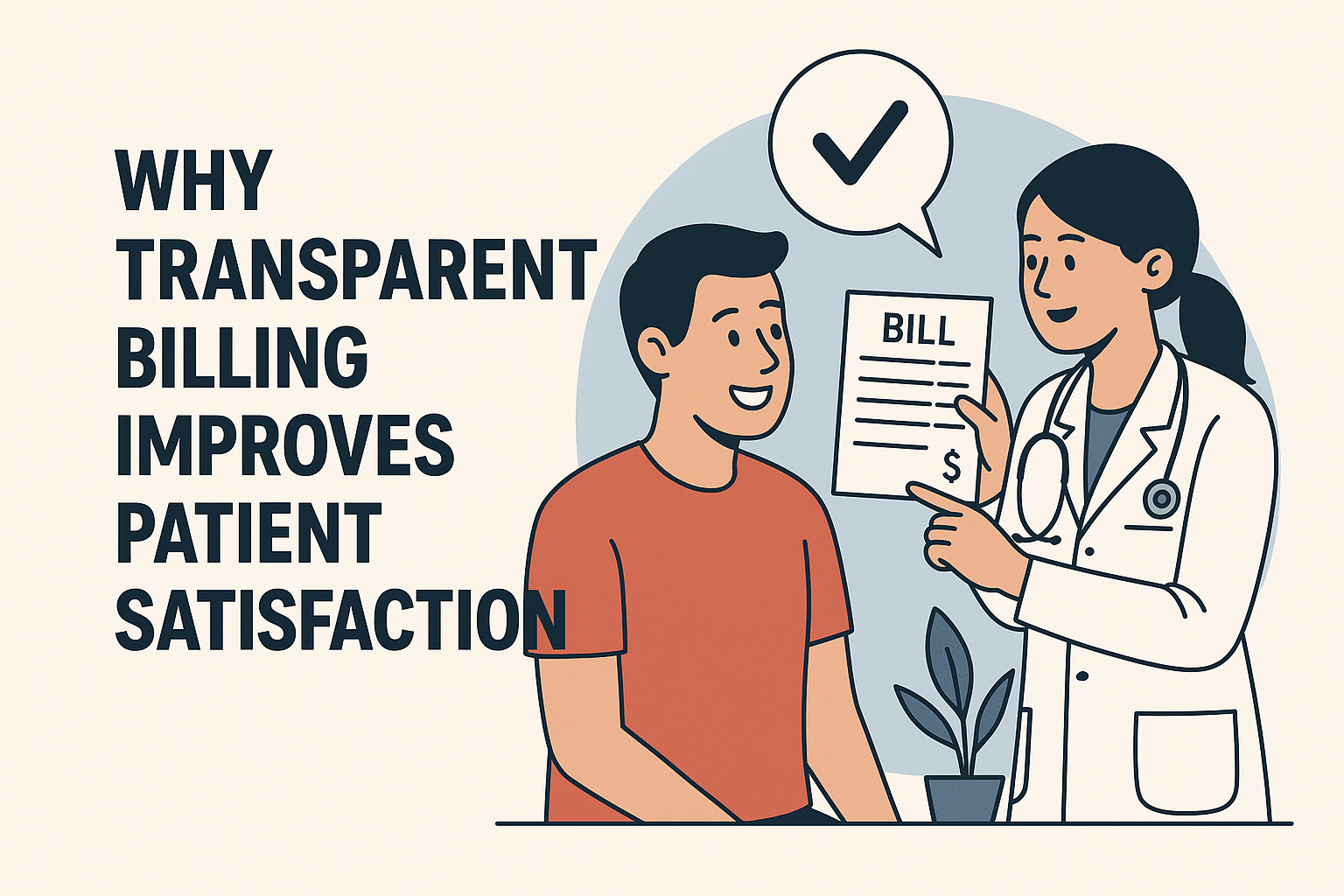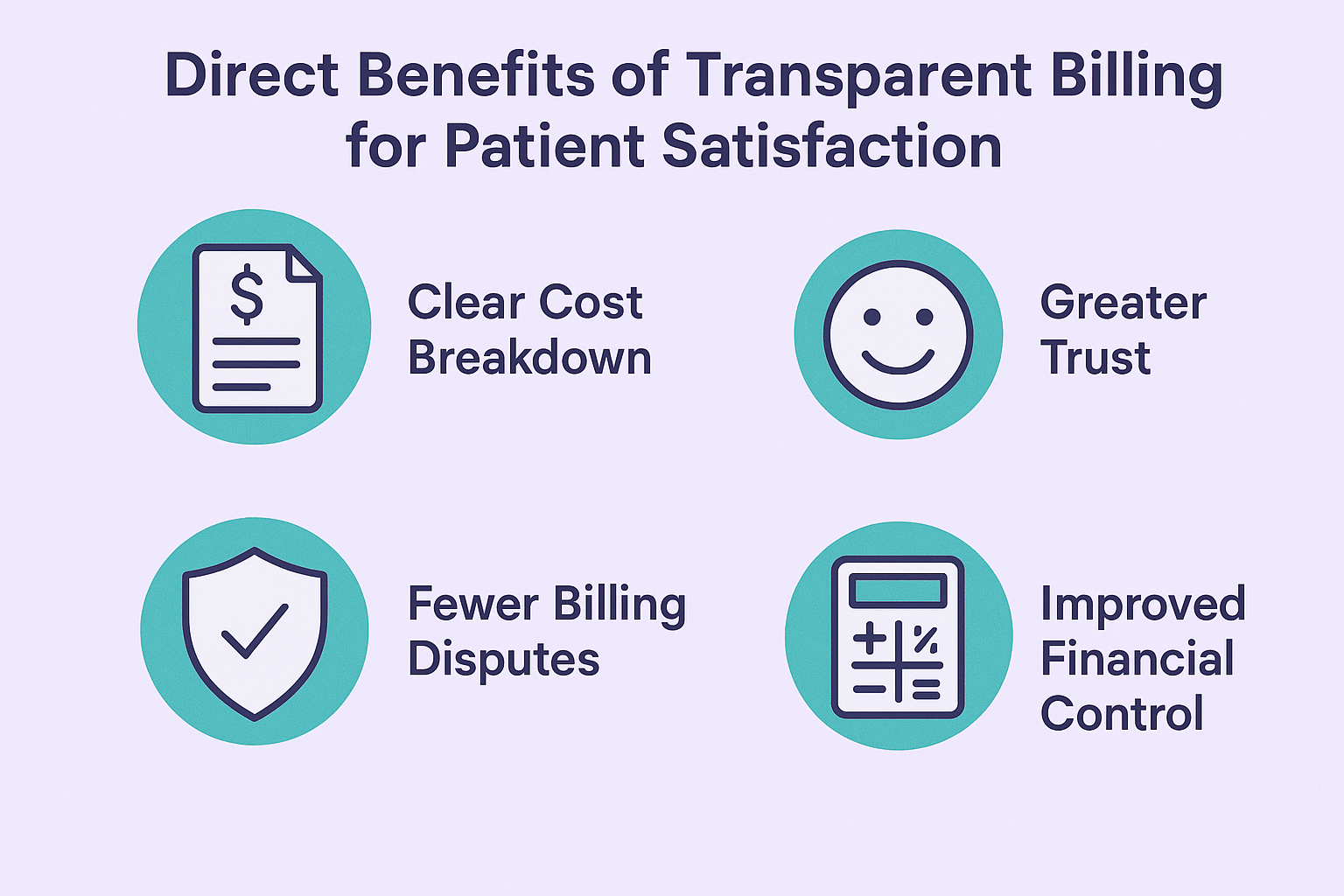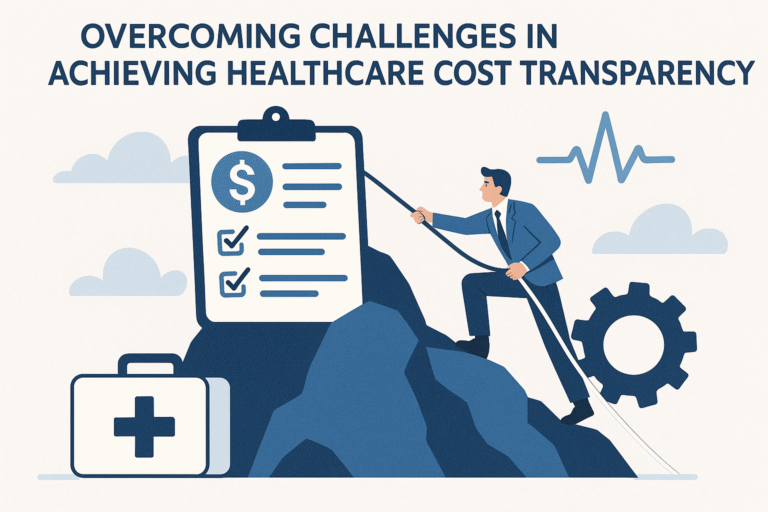Why transparent billing improves patient satisfaction
Imagine a patient leaving a doctor’s office, feeling relieved after a successful visit, only to be hit with a medical bill weeks later that is confusing, unexpectedly high, and impossible to decipher. This common scenario breeds anxiety, frustration, and a deep sense of distrust. In today’s healthcare landscape, where patients are increasingly responsible for a larger share of their medical costs, the mystery surrounding billing is no longer acceptable. The solution? Transparent medical billing. This article delves into how embracing billing clarity transforms the patient experience, fostering higher patient satisfaction, building profound patient trust, and ultimately streamlining the entire revenue cycle for healthcare providers.

Key Takeaways
- Enhanced Patient Trust: Transparent medical billing practices build confidence and trust between patients and providers by eliminating financial surprises and promoting open communication.
- Improved Patient Satisfaction: Clear, understandable bills reduce anxiety and confusion, leading to a more positive overall healthcare experience and higher patient satisfaction scores.
- Fewer Payment Disputes: When patients understand what they are paying for and why, the likelihood of disputes, non-payment, and collection issues significantly decreases.
- Streamlined Revenue Cycle: Billing clarity leads to faster payments, reduced administrative burden, and improved cash flow for healthcare organizations.
- Competitive Advantage: Practices prioritizing healthcare cost transparency stand out, attracting and retaining patients who value financial predictability and honesty.
The Growing Demand for Healthcare Cost Transparency
The healthcare industry is undergoing a significant shift. Patients are no longer passive recipients of care; they are active consumers, making choices based on quality, convenience, and increasingly, cost. This evolution is driven by several factors that underscore the critical need for healthcare cost transparency.
Shifting Patient Expectations
Modern patients expect clarity and control in all aspects of their lives, and healthcare is no exception. They are accustomed to online price comparisons for almost everything else they purchase, from electronics to travel. When it comes to their health, they want to understand the financial implications of their treatment options upfront. This consumer mindset means that opaque billing practices are no longer just an inconvenience; they are a major source of dissatisfaction. Patients expect to know what they are paying for, how much it will cost, and how their insurance will factor in, even before services are rendered.
The Impact of High-Deductible Plans
The rise of high-deductible health plans (HDHPs) has dramatically shifted more financial responsibility onto patients. With higher deductibles, patients are paying more out-of-pocket before their insurance benefits fully kick in. This direct financial impact makes them far more sensitive to costs and far more scrutinizing of their medical bills. A bill that might have once been largely covered by insurance is now a direct hit to their personal finances. This increased financial burden magnifies the need for billing clarity and accurate pre-service estimates. Patients need to budget for healthcare expenses just as they would for any other significant purchase.
Regulatory Push Towards Transparency
Governments and regulatory bodies are also pushing for greater healthcare cost transparency. In the United States, for instance, the Hospital Price Transparency Rule mandates that hospitals publicly disclose their standard charges for all services. While this is a step, the spirit behind such regulations extends to all healthcare providers: the belief that patients have a right to know the cost of their care. These regulations, though sometimes complex in their implementation, signal a clear direction: transparency is becoming a non-negotiable standard, not just a nice-to-have. Practices that proactively embrace this trend will be ahead of the curve.
What Constitutes Transparent Medical Billing?
At its core, transparent medical billing means providing patients with clear, accurate, and easily understandable information about the costs of their healthcare services before, during, and after treatment. It’s about demystifying the complex world of medical coding, insurance adjustments, and patient responsibilities.
Key elements of a truly transparent billing system include:
- Itemized Statements: Bills should clearly list each service received, the date it was provided, the specific charge for that service, and how insurance adjustments (if any) have been applied. Generic line items like “medical services” are unhelpful and lead to confusion.
- Pre-Service Estimates: Before a procedure or visit, patients should receive a good-faith estimate of their out-of-pocket costs. This estimate should consider their insurance benefits, deductible, co-pays, and co-insurance. This is arguably the most crucial step in preventing “surprise” bills.
- Clear Explanation of Insurance Benefits and Deductibles: Patients often struggle to understand their Explanation of Benefits (EOB) from their insurer. A transparent practice helps patients bridge this gap, explaining how their deductible works, what their co-pay covers, and why certain services might not be fully reimbursed.
- Accessible Billing Support: Patients need easy access to knowledgeable staff who can answer their billing questions, explain charges, and help them navigate insurance complexities. This could be a dedicated phone line, an online chat function, or in-person assistance.
- Multiple, Flexible Payment Options: Offering various ways to pay (online portals, payment plans, credit card, ACH) demonstrates a commitment to patient convenience and understanding. It also acknowledges that healthcare costs can be significant.
Direct Benefits of Transparent Billing for Patient Satisfaction
The most immediate and profound impact of transparent medical billing is on the patient’s experience. When financial clarity is prioritized, patients feel respected, informed, and empowered, leading directly to higher patient satisfaction.

Fostering Patient Trust and Confidence
Unclear bills erode patient trust. When patients receive a bill they don’t understand or that seems unexpectedly high, they may feel misled or even exploited. Conversely, clear, upfront communication about costs builds confidence. Patients feel that their provider is honest and has their best interests at heart, not just their wallet. This trust extends beyond billing; it reinforces the overall therapeutic relationship.
“Trust is the cornerstone of patient satisfaction in healthcare. Transparent billing is a tangible way to build and maintain that trust.”
When patients trust their healthcare provider, they are more likely to follow treatment plans, return for future care, and recommend the practice to others. This creates a virtuous cycle of positive engagement.
Reducing Billing Confusion and Anxiety
The sheer complexity of medical billing can be overwhelming. Jargon, codes, and seemingly arbitrary charges can cause significant stress and anxiety for patients, especially when they are already dealing with health concerns. Billing clarity demystifies this process. When a patient receives an itemized statement that clearly shows what was done, why it cost what it did, and what their responsibility is, much of that anxiety dissipates.
🤯 Imagine a patient’s surprise when they receive a bill for hundreds of dollars more than expected. 😄 Now imagine that same patient receiving a clear, understandable estimate before their procedure, allowing them to prepare financially.
This shift from surprise to predictability is a powerful driver of patient satisfaction. It transforms a potential point of contention into an opportunity for reassurance and understanding.
Empowering Patients with Financial Clarity
Healthcare cost transparency empowers patients to make informed decisions about their care. If a patient knows the estimated cost of a procedure, they can discuss alternatives, understand the value proposition, or even explore financial assistance options. This control over their financial health contributes significantly to their overall sense of satisfaction and autonomy.
Consider the difference in patient experience:
| Before Transparent Billing | After Transparent Billing |
|---|---|
| ❌ Patient receives a large, unexpected bill. | ✅ Patient receives a clear pre-service estimate. |
| ❌ Patient feels confused and frustrated by complex codes. | ✅ Patient receives an itemized bill with plain language explanations. |
| ❌ Patient calls billing office repeatedly with questions. | ✅ Patient uses an online portal to review charges and pay. |
| ❌ Patient delays care due to fear of unknown costs. | ✅ Patient confidently proceeds with care, knowing the financial plan. |
| ❌ Patient shares negative experiences with friends/family. | ✅ Patient feels respected and satisfied, sharing positive feedback. |
This empowerment leads to better adherence to care plans and a more collaborative patient-provider relationship.
Decreasing Payment Disputes and Complaints
A significant portion of payment disputes and patient complaints in healthcare stems from a lack of understanding about charges. When bills are clear and estimates are provided upfront, the reasons for disagreement diminish. Patients are more likely to pay their bills promptly when they understand and agree with the charges. This leads to fewer calls to the billing department, less time spent on collections, and a smoother financial process for both parties. It transforms potential conflict into mutual understanding.
Improving Communication and Relationships
Billing clarity opens lines of communication. When staff are trained to explain bills clearly and empathetically, it enhances the patient-provider dialogue. Patients feel heard and valued when their financial concerns are addressed with patience and expertise. This positive communication reinforces the overall relationship, making patients feel like partners in their healthcare journey rather than just customers. This improved communication extends beyond the billing office, positively influencing the perception of the entire practice.
Beyond Satisfaction: Business Advantages of Billing Clarity
While patient satisfaction is a primary goal, the benefits of transparent medical billing extend significantly to the operational and financial health of a healthcare practice. It’s not just a patient-centric initiative; it’s a smart business strategy.
Streamlined Revenue Cycle Management
One of the most compelling business arguments for transparent medical billing is its positive impact on the revenue cycle. When patients understand their financial obligations, they are more likely to pay on time. This reduces the need for extensive collections efforts, minimizes bad debt, and improves cash flow.
Benefits for Revenue Cycle Management (RCM):
- Faster Payments: Clear bills lead to quicker patient payments.
- Reduced Accounts Receivable (AR) Days: Money comes in faster.
- Lower Collection Costs: Less need for expensive collection agencies.
- Fewer Denials and Appeals: Proactive communication about insurance can reduce these issues.
- Decreased Bad Debt: Less money written off due to non-payment.
- Improved Cash Flow: Predictable and steady income stream.
This efficiency allows practices to allocate resources more effectively, focusing on patient care rather than chasing payments.
Enhanced Patient Loyalty and Retention
Satisfied patients are loyal patients. Practices that prioritize billing clarity and overall patient experience are more likely to retain their existing patient base. In a competitive healthcare market, patient loyalty translates directly into sustainable growth. Loyal patients are less likely to seek care elsewhere, even if other providers offer slightly lower prices, because they value the trust and positive experience they have with their current provider.
Positive Online Reviews and Reputation
In the digital age, a practice’s online reputation is paramount. Patients often share their experiences online through reviews on platforms like Google, Yelp, and Zocdoc. Billing issues are a frequent source of negative reviews, which can deter new patients. Conversely, practices known for their healthcare cost transparency and excellent patient service often receive glowing reviews, attracting more prospective patients. A strong online reputation built on trust and clarity is an invaluable asset.
Reduced Administrative Burden
While implementing transparent practices requires an initial investment in training and systems, it ultimately reduces the administrative burden on staff. Fewer calls about confusing bills, fewer disputes to resolve, and less time spent on collections frees up administrative staff to focus on more productive tasks, such as scheduling, patient intake, and supporting clinical operations. This leads to a more efficient and less stressful work environment for your team.
Implementing Transparent Billing Practices: A Step-by-Step Guide
Transitioning to a truly transparent medical billing system requires a systematic approach and commitment from leadership. It’s an investment that pays significant dividends in patient satisfaction and operational efficiency.
1. Educate Your Staff
Your staff are the frontline representatives of your practice. They need to be fully equipped to explain complex billing concepts in simple, understandable terms.
- Comprehensive Training: Provide ongoing training on insurance nuances, common billing codes, and how to explain an EOB.
- Empathy and Communication Skills: Train staff to listen empathetically to patient concerns and communicate clearly and patiently. Role-playing scenarios can be very effective.
- Resource Knowledge: Ensure staff know where to direct patients for further assistance (e.g., financial counselors, online resources).
2. Provide Pre-Service Estimates
This is perhaps the most impactful step in achieving healthcare cost transparency.
- Automated Tools: Utilize software that can generate accurate, real-time estimates based on patient insurance information and proposed services.
- Clear Disclaimers: Always include a disclaimer that estimates are not guarantees, as unforeseen complications or changes in care can occur.
- Discuss Options: When presenting estimates, discuss different treatment options and their associated costs, allowing patients to make informed choices.
3. Simplify Billing Statements
Medical bills are notorious for their complexity. Redesign them with the patient in mind.
- Plain Language: Avoid jargon and acronyms. Use simple, everyday language.
- Clear Layout: Use bolding, bullet points, and ample white space. Organize information logically (e.g., services rendered, charges, insurance payment, patient responsibility).
- Key Information Prominently Displayed: Ensure the patient’s balance due, payment due date, and how to pay are immediately visible.
- Contact Information: Clearly state how patients can get help with billing questions.
- Example elements to include on a simplified bill:
- Service Date
- Provider Name
- Description of Service (e.g., “Office Visit – Established Patient,” not just “99213”)
- CPT Code (for reference, but explain what it means)
- Total Charge
- Insurance Paid
- Patient Responsibility (Deductible, Co-pay, Co-insurance)
- Amount Due
- Payment Options
4. Offer Accessible Billing Support
Patients need to know they can get help when they have questions.
- Dedicated Billing Line: A direct phone number for billing inquiries, separate from the appointment line.
- Online Portal: A secure patient portal where patients can view their statements, payment history, make payments, and submit billing questions.
- Frequently Asked Questions (FAQs): A comprehensive online or printed FAQ section addressing common billing concerns.
- Financial Counseling: For complex cases or patients facing significant financial burdens, offer access to financial counselors.
5. Embrace Technology Solutions
Technology can significantly streamline the process of transparent medical billing.
- Practice Management Systems (PMS) with Billing Modules: Many modern PMS platforms offer features like automated estimate generation, electronic claim submission, and patient portal integration.
- Patient Portals: Crucial for allowing patients to access their billing information 24/7, make payments, and communicate securely.
- Automated Payment Plans: Software that manages recurring payments for patients.
- Price Transparency Tools: Tools that can pull data on common procedure costs and insurance rates.
6. Establish Clear Payment Policies
Communicate your payment expectations clearly and upfront.
- Payment Plans: Offer flexible payment plans for larger balances.
- Financial Assistance Programs: Publicize any programs for patients who qualify for assistance.
- Point-of-Service Collections: Encourage co-pays and known patient portions to be collected at the time of service.
Overcoming Challenges in Achieving Healthcare Cost Transparency
While the benefits are clear, implementing healthcare cost transparency is not without its hurdles. Practices may encounter several challenges:

Complexity of Insurance Contracts
Understanding the myriad of insurance plans, deductibles, co-pays, co-insurance, and out-of-pocket maximums is incredibly complex, even for billing professionals. Explaining an Explanation of Benefits (EOB) to a patient in simple terms can be challenging, especially when the EOB itself is confusing. Overcoming this requires ongoing staff training and leveraging technology that can interpret and simplify this data.
Staff Training and Resistance to Change
Any significant change within an organization can be met with resistance. Staff may be comfortable with existing processes, even if they are inefficient. Training takes time and resources. It’s essential to communicate the “why” behind the changes – how it benefits both patients and the practice – to gain staff buy-in. Investing in robust training programs and providing clear guidelines can mitigate this challenge.
Technology Integration
Adopting new billing software or integrating patient portals can be a significant undertaking. There are upfront costs, potential disruptions during implementation, and a learning curve for staff. However, the long-term efficiencies and improved patient satisfaction often outweigh these initial challenges. Phased implementation and thorough testing can help ensure a smoother transition.
Fear of Price Shopping
Some providers might fear that healthcare cost transparency will lead to patients simply “price shopping” for the cheapest option. While price is a factor, most patients prioritize quality of care, trust, and a positive overall experience. Transparency builds trust, which can be a stronger differentiator than simply being the lowest cost. Practices should emphasize their value proposition—quality outcomes, compassionate care, and transparent practices—to differentiate themselves.
Conclusion: The Indispensable Role of Transparent Medical Billing
In an era where patients are more informed and financially responsible for their healthcare than ever before, transparent medical billing is no longer a luxury but a necessity. It is the cornerstone of building enduring patient trust, significantly improving patient satisfaction, and fostering a more harmonious patient-provider relationship. Beyond the direct benefits to the patient experience, embracing billing clarity offers tangible advantages to healthcare organizations, including smoother revenue cycle management, reduced administrative burdens, and a stronger market reputation.
By proactively addressing the demand for healthcare cost transparency, practices can differentiate themselves, cultivate patient loyalty, and establish a foundation for long-term success. The path to a better patient experience and a more efficient practice begins with a clear, honest, and understandable bill.
Ready to enhance your patient experience and financial health? Evaluate your current billing practices and identify areas where you can implement greater transparency. Invest in staff training, leverage technology, and commit to clear communication. Your patients—and your bottom line—will thank you.
